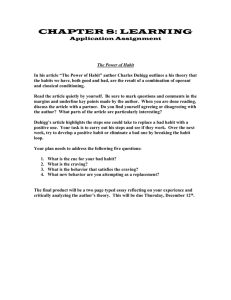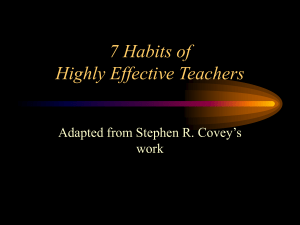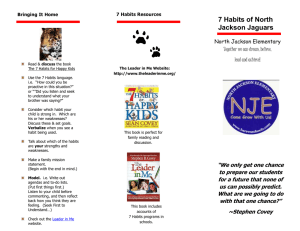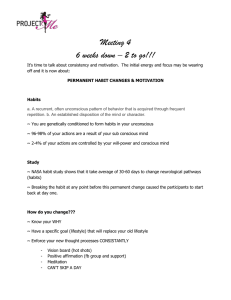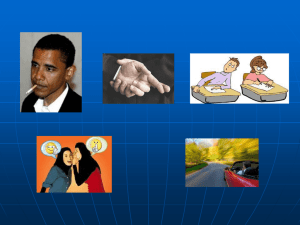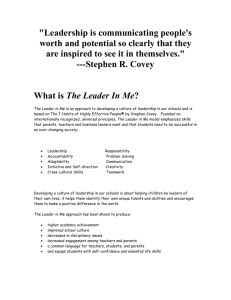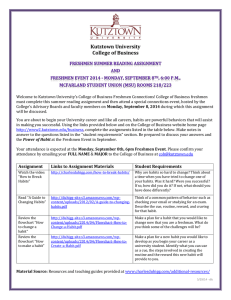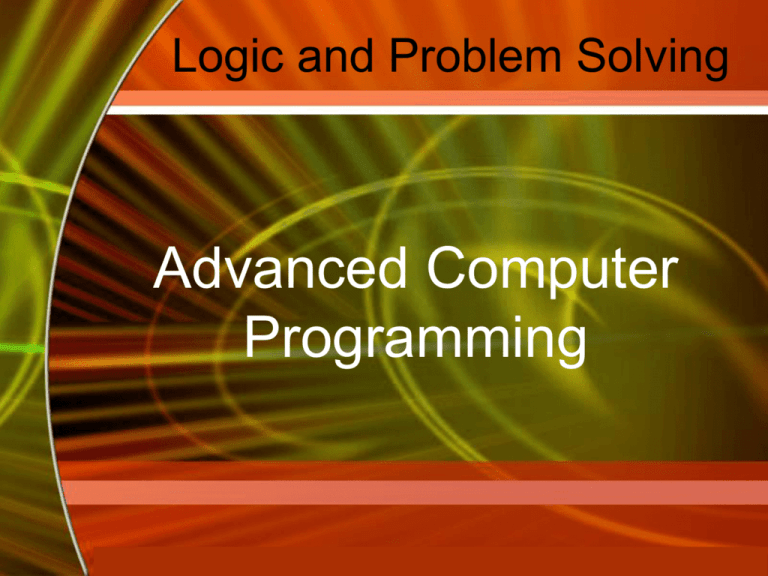
Logic and Problem Solving
Advanced Computer
Programming
McGraw-Hill Technology Education
Copyright © 2006 by The McGraw-Hill Companies, Inc. All rights reserved.
Lecture Objective
• After completing this Lecture:
– We will be able to apply the six-step
approach to problem-solving.
13A-2
Enabling Objectives
• Identify the six steps in problem solving
• Describe the purpose of each step in
problem solving
• Explain the actions to be taken in each
step
• Apply techniques for promoting creativity
in problem solving for use with both
individuals and groups
13A-3
Problem-Solving Steps
•
•
•
•
•
•
13A-4
Recognize that there is a problem
Identify the problem
Generate alternative solutions
Choose among the alternative solutions
Implement the chosen solution
Evaluate the solution
Left Brain Characteristics
• Follows a logical pattern
• Is objective
• Views time chronologically, hour by hour,
day by day
• Sees things as true or false, black or
white
• Seeks details
• Holds short-term memory
• Thinks critically, perhaps negatively,
asks “why?”
13A-5
Right Brain Characteristics
13A-6
• Follows intuitive hunches
• Creates patterns, without following a
step-by-step process
• Is subjective
• Views time in a total sense—a lifetime, a
career, a project
• Sees the “whole” rather than the details
• Thinks positively, unconstrained by
preconceived ideas
• Asks “why not?” and breaks rules
Techniques for Recognizing Problems
• Comparison against others
• Comparison of current performance with
objectives or past performance
• Checklists
• Inverse Brainstorming
• Listing complaints
• Role playing
13A-7
Identify the Problem: Ask Who?
•
•
•
•
13A-8
Who says that this is a problem?
Who caused or is causing the problem?
Whom does it or will it affect?
Who has done something about the
problem?
Identify the Problem: Ask What?
•
•
•
•
What happened or will happen?
What are the symptoms?
What are the consequences to others?
What circumstances surround the
occurrence of the problem?
• What is not functioning as desired?
13A-9
Identify the Problem: Ask When?
• When did it or will it happen?
• When did it first occur?
13A-10
Identify the Problem: Ask Where?
• Where is the problem occurring?
• Where did it or will it have an impact?
13A-11
Identify the Problem: Ask Why?
• Why is this a problem?
• Why did it or will it occur?
• Why was nothing done to prevent the
problem from occurring?
• Why did no one recognize and do
something about the problem sooner?
• Why is a response needed now?
13A-12
Identify the Problem: Ask How?
• How should the process be working?
• How are others dealing with this or
similar problems?
• How do you know this is a problem;
what supporting information do you
have?
13A-13
Problem Identification: Final Questions
• How will you know the problem is
solved?
• What does the desired state look like?
• What data will you need to answer these
questions?
13A-14
Techniques for Identifying the Problem
•
•
•
•
13A-15
Talking to others
Consensus building
Fishbone diagram
Why-Why diagram
Problem Statement
• The end result of problem identification.
• Brief, clear, to-the-point identification of
the specific problem to be addressed,
including the key rationale for why it
should be solved.
13A-16
Individual Techniques for Generating Solutions
•
•
•
•
•
•
13A-17
Analysis of past solutions
Fresh eyes
Mind mapping
Sleeping on it
Visualization
What if?
Advantages of Using a Group
• Shared knowledge and experience will
broaden the search and generate more
alternative solutions.
• Leads to a better understanding of how
and why a decision was made and it will
be accepted more readily.
13A-18
Advantages of Using a Group
• Members who are willing to take more
risks and those who avoid risks
contribute to the scope of possible
solutions and move each other to the
middle ground of risk taking in choosing
a solution for implementation.
• Collective judgment is usually better
than that of an individual.
13A-19
Limitations of Using a Group
• Pressure to conform may negatively
influence decision-making.
• One person may dominate the group.
• A group requires more time to reach a
decision than do individuals.
• Groups generally don’t make better
decisions than an expert or someone
with special knowledge and skills.
13A-20
Choosing Among Alternative Solutions
•
•
•
•
13A-21
How practical is the idea?
Is it realistic?
How cost-effective is it?
Can it be easily implemented by a
limited number of individuals, or does it
require that large numbers of other
people be convinced that it is a good
idea? Will they be easy to convince?
• Is the idea consistent with the directions
already undertaken by the organization?
Implement the Chosen Solution
• What resources are needed?
• Who else within the organization needs to
approve the solution to the problem, and what
will it take to win their approval?
• What has to happen in order to implement the
solution; what are the steps in
implementation?
• Who is going to be involved, and what will
they do?
• When will the various phases of
implementation take place?
13A-22
7 Habits of Highly effective people
• Habit 1
– Be Proactive
• Take the initiative and make things happen.
• If you make mistakes, acknowledge it and learn
from it
• Habit 2
– Begin with the End in Mind
• Determine the right things to accomplish and
then how to best accomplish them.
7 Habits of Highly effective people
• Habit 3
– Put First things First
• Continually review and prioritize your goals.
• Focus on the important tasks, the ones that will
have impact if carefully thought out and planned
• Habit 4
– Think Win/Win
• Win/Win is the frame of mind that seeks mutual
benefits for all people involved in solutions and
agreements.
7 Habits of Highly effective people
• Habit 5
– Seek First to Understand
then to be Understood
• Learn as much as you can, about the situation.
• “Listen, listen, listen”.
• Present things logically, not emotionally,
• Habit 6
– Synergize
• Make the whole greater than the some of its
parts.
• Value the differences in the people you work
with.
7 Habits of Highly effective people
• Habit 7
– Renewal
• Renew the four dimensions of your nature.
– Physical
» Exercise, Nutrition, Stress Management
– Mental
» Reading, Thinking, Visualizing, Planning, Writing
– Spiritual
» Value Clarification and Commitment, Meditation
– Social/Emotional
» Service, Empathy, Self-esteem, Synergy
The NotePad Project
•
•
•
•
•
•
•
•
•
What was required
What we did
How we did
Possible Alternatives
Evaluate
What we learnt
Re-usable components
Code Snippets
Optimize
The End
Questions?
McGraw-Hill Technology Education
Copyright © 2006 by The McGraw-Hill Companies, Inc. All rights reserved.




